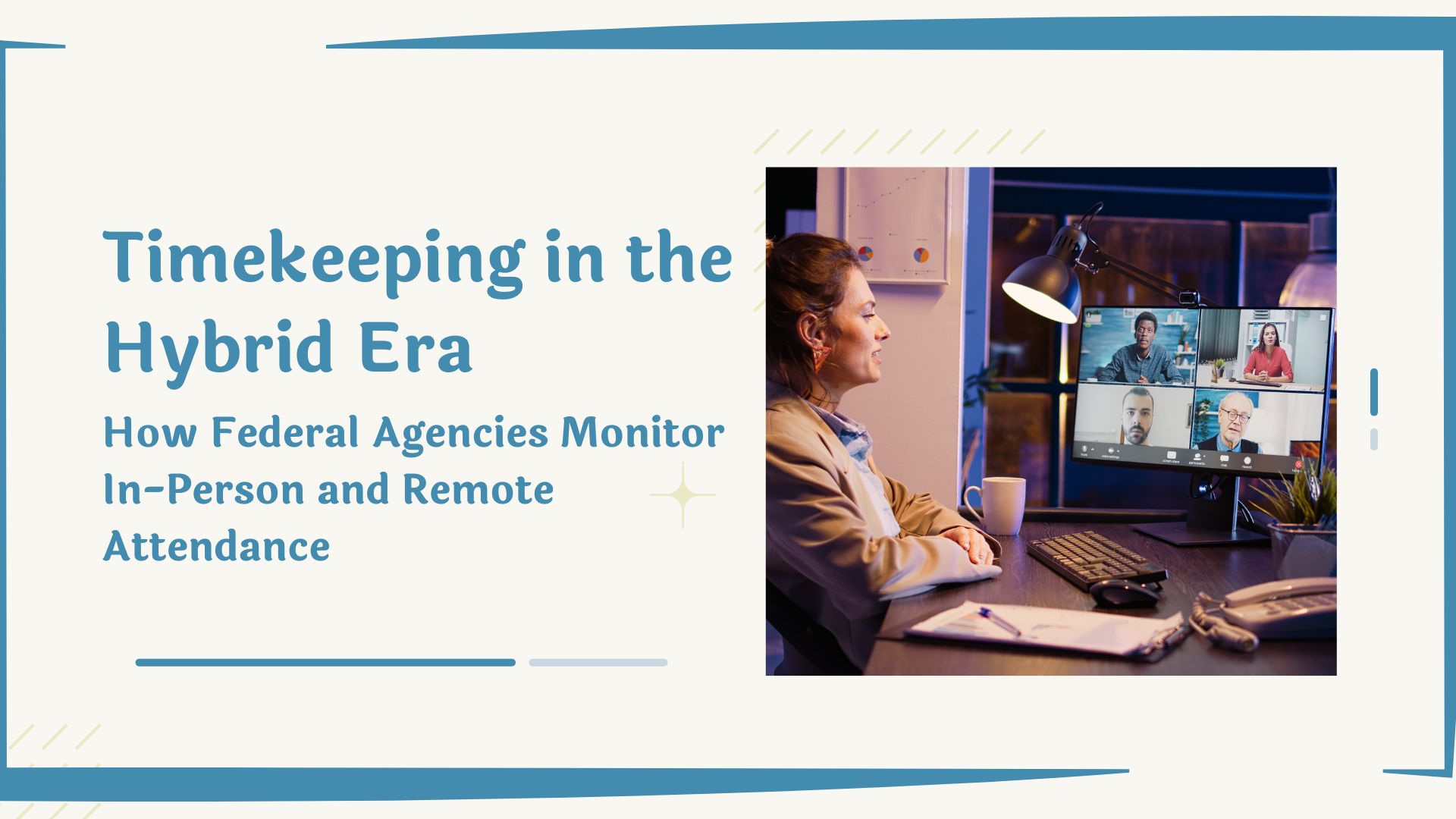As workplaces evolve, federal agencies nationwide are navigating the challenge of effectively monitoring employee time and attendance in in-person and remote environments. Balancing accountability, efficiency, and employee flexibility requires reliable systems, and attendance reporting tools are at the heart of this transformation. Attendance Reporting Tools have become essential for federal agencies to manage workforce operations, ensure compliance, and maintain productivity. These tools enable agencies to accurately and reliably monitor work hours, leave requests, overtime, and remote work activities. In this blog, we explore how federal agencies monitor time and attendance, the role of Attendance Reporting Tools, and why these solutions are critical for managing traditional office and hybrid or remote setups.
The Importance of Time and Attendance Monitoring
Monitoring time and attendance for federal agencies is about more than just payroll. It’s essential for:
- Ensuring compliance with federal labor laws
- Managing workforce capacity and resource planning
- Tracking performance and productivity
- Supporting fair compensation practices
- Maintaining accountability across both on-site and remote work environments
As the federal workforce becomes more flexible, Attendance Reporting Tools are crucial for bridging team gaps, providing transparency, and maintaining service levels.
Traditional Time and Attendance Monitoring
In traditional in-person settings, federal agencies have long used systems such as:
- Time clocks or badge swipe systems
- Sign-in sheets
- Supervisor approvals of work hours
- Manual entry into centralized systems
While these methods worked well in physical office environments, they were often labor-intensive and prone to human error. Attendance Reporting Tools have significantly improved these processes by automating data collection and integrating time-tracking functions into centralized platforms. For example, badge swipe data can now be automatically uploaded into Attendance Reporting Tools, reducing the need for manual reconciliation and improving accuracy.
Transition to Remote and Hybrid Work
The growth of remote and hybrid work models has introduced fresh challenges for federal agencies. Without physical offices as the central hub, agencies needed to rethink how to track employee time, attendance, and productivity. Attendance Reporting Tools have become the backbone of remote work management by offering:
- Cloud-based time tracking
- Mobile check-ins and check-outs
- GPS-based attendance verification
- Automatic notifications are sent when punches are missed, or work patterns appear inconsistent.
- Integration with project management tools
These features allow agencies to monitor remote employees with the same level of precision as in-person teams. Employees can track their hours from anywhere, while managers can access attendance data and create reports instantly.
How Attendance Reporting Tools Help Federal Agencies
Attendance Reporting Tools offer several key benefits to federal agencies:
- Real-Time Data
With Attendance Reporting Tools, managers can access live data on employee attendance, making it easier to identify issues quickly and adjust staffing or schedules as needed.
- Compliance Management
Federal agencies must comply with strict labor and reporting requirements. Attendance Reporting Tools help agencies stay compliant by automatically tracking hours worked, overtime, and leave balances.
- Integration With Payroll Systems
Many Attendance Reporting Tools integrate directly with payroll software, reducing administrative work and ensuring employees are paid accurately and on time.
- Customizable Reporting
Agencies can use Attendance Reporting Tools to generate detailed reports by team, department, or individual, which helps with resource planning and performance reviews.
- Improved Employee Accountability
By using Attendance Reporting Tools, agencies set clear expectations around work hours and attendance. This creates an accountability culture, whether employees work on-site or remotely.
Features Federal Agencies Look For
When selecting Attendance Reporting Tools, federal agencies prioritize several features to meet their complex needs:
- Secure login and authentication systems to protect sensitive data
- Mobile and desktop access to accommodate diverse work environments
- Flexible time tracking options such as clock-in/clock-out, project-based time tracking, and attendance verification
- Automatic alerts keep employees and managers informed about attendance issues or irregularities.
- Leave and absence management to handle vacation, sick leave, and federal holidays.
- Detailed audit trails to ensure transparency and prepare for compliance reviews
Attendance Reporting Tools’ features help agencies maintain consistency across multiple locations and job types.
Addressing Remote Work Challenges
Remote work introduces specific challenges that Attendance Reporting Tools help address:
- Lack of physical oversight: Attendance Reporting Tools provide a digital record of employee activity, ensuring accountability without in-person supervision.
- Communication gaps: These tools often include dashboards and reports that improve employee and manager visibility.
- Time zone differences: For agencies with employees in multiple time zones, attendance reporting tools allow local time tracking while standardizing data for payroll and reporting.
- Work-life balance concerns: By tracking work hours accurately, agencies can help employees avoid overwork and burnout.
Enhancing Productivity and Engagement
Monitoring time and attendance isn’t just about control—it’s about supporting productivity and engagement. Attendance Reporting Tools help federal agencies identify patterns, such as employees consistently working long hours or frequently missing time, that may signal underlying issues. With this data, managers can have meaningful conversations with employees, offer support, and implement changes that improve work-life balance and overall performance. Many Attendance Reporting Tools also provide self-service portals where employees can view attendance data, request leave, or update personal information. Providing this level of transparency builds trust and boosts employee engagement.
The Role of Automation and AI
Automation and AI are increasingly embedded in Attendance Reporting Tools, offering new levels of efficiency and insight. Federal agencies are using these technologies to:
- Predict absenteeism trends
- Identify potential compliance risks.
- Optimize schedules and resource allocation.
- Flag anomalies or timecard discrepancies automatically
By reducing manual tasks, Attendance Reporting Tools free up HR and management teams to focus on more strategic activities, such as workforce planning and employee development.
Case Examples: Federal Agencies in Action
- Department of Health and Human Services (HHS)
HHS uses Attendance Reporting Tools to monitor attendance across a large, dispersed workforce. With cloud-based systems, they track both on-site and remote staff and ensure timely, accurate payroll processing.
- Department of Veterans Affairs (VA)
The VA relies on Attendance Reporting Tools to manage flexible schedules and remote work for healthcare providers and administrative staff. The tools help the VA maintain high-quality service delivery while supporting employee flexibility.
- General Services Administration (GSA)
GSA uses Attendance Reporting Tools to oversee employee time across multiple offices and ensure compliance with federal work-hour regulations. The tools help streamline reporting and improve resource allocation.
The Future of Attendance Tracking in Federal Agencies
As remote and hybrid work becomes a permanent fixture, federal agencies will continue to rely on sophisticated Attendance Reporting Tools. Future developments may include:
- More advanced AI-driven analytics
- Biometric verification for added security
- Greater integration with collaboration tools
- Enhanced mobile app capabilities
Attendance Reporting Tools will remain essential for ensuring federal agencies can adapt to workforce changes while maintaining compliance and operational efficiency. Federal agencies face unique challenges in managing employee time and attendance across in-person and remote settings. Attendance Reporting Tools have emerged as critical solutions, helping agencies track work hours, monitor compliance, and improve productivity. By adopting Attendance Reporting Tools, federal agencies can create more flexible, accountable, and engaged workplaces — all while meeting the high standards required of public service organizations. As technology advances, these tools will play an even greater role in shaping the future of federal workforce management.
Sources:
- U.S. Office of Personnel Management (OPM) – https://www.opm.gov/policy-data-oversight/worklife/telework
- Government Accountability Office (GAO) – https://www.gao.gov/federal-telework
- U.S. Department of Labor – https://www.dol.gov/agencies/whd
- Office of Management and Budget (OMB) – https://www.whitehouse.gov/omb





